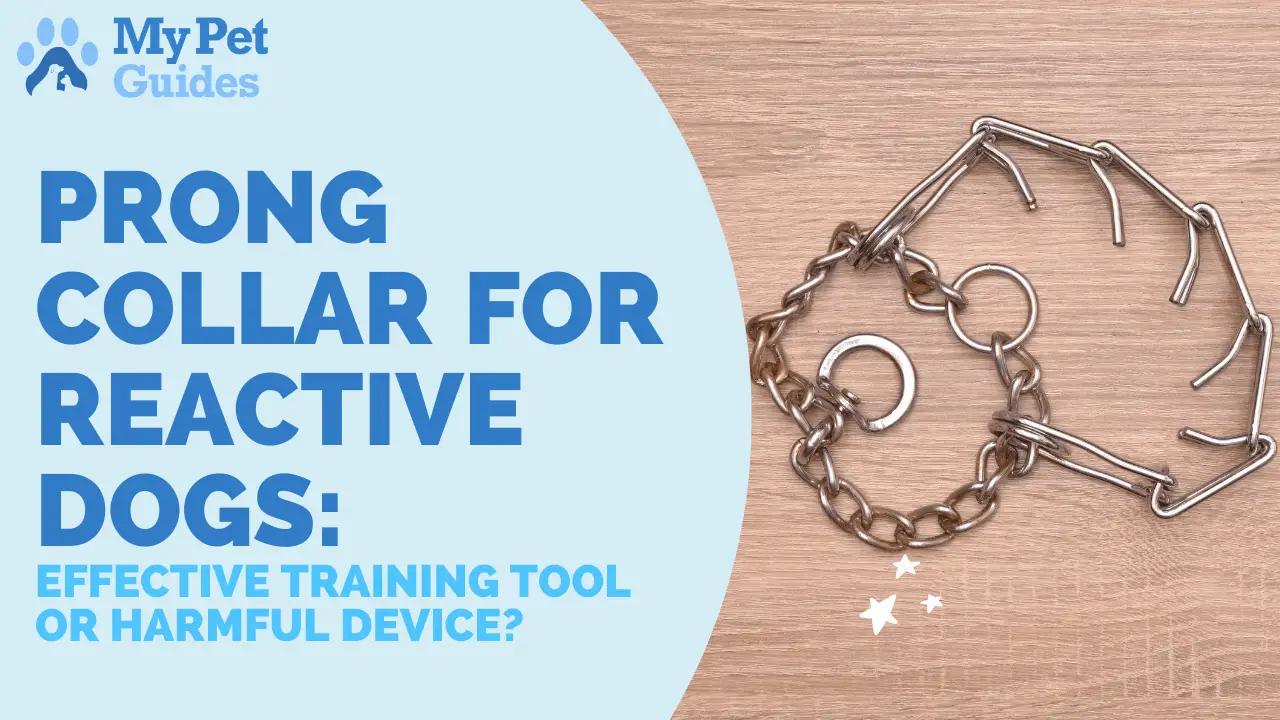Prong collars have been a topic of controversy in the dog training world for many years. Some trainers swear by them, while others consider them inhumane and dangerous. However, when used correctly, prong collars can be a helpful tool for training reactive dogs.
Reactive dogs overreact to certain stimuli, such as other dogs, people, or loud noises. This behavior can be challenging, and traditional training methods may not always be effective. Prong collars can provide an added level of control and help redirect the dog’s attention away from its triggers. However, it is crucial to note that prong collars should only be used under the guidance of a professional trainer with experience using this tool.
Understanding Prong Collars
Prong collars, also known as pinch collars, are a type of training collar designed to help dog owners control their pets. These collars are made of metal links with metal prongs that gently pinch a dog’s neck when tightened. They are often used for reactive, aggressive dogs or pull on the leash.
Prong collars come in different sizes and colors to fit different breeds and personalities. Some prong collars have a center plate that distributes pressure more evenly, while others have micro prongs that are less noticeable. Some prong collars also have rubber tips to reduce discomfort and prevent injury.
It is important to note that prong collars are not meant to be used as a punishment or to cause pain to the dog. They are designed to provide a quick and effective correction to unwanted behavior. When used correctly, prong collars can be an effective tool for training dogs.
Learning how to use a prong collar properly before using it on your dog is essential. It is recommended to seek the help of a professional dog trainer who can show you how to use the collar correctly and safely. Monitoring your dog’s behavior and ensuring the collar is not causing harm or discomfort is also important.
In summary, prong collars are a type of training collar designed to help dog owners control their pets. They come in different sizes and colors and can have different features, such as a center plate, micro prongs, or rubber tips. While prong collars can be an effective tool for training dogs, using them correctly and safely is important.
Prong Collars vs. Other Training Tools
Regarding training reactive dogs, various tools are available in the market. Prong collars, choke collars, harnesses, gentle leaders, and shock collars are some of the most common. The question arises: which one is better?
Prong collars are often popular for dog owners who have tried other training tools without success. They are designed to quickly and effectively correct the dog’s behavior. The prongs on the collar apply pressure to the dog’s neck when they pull, which causes discomfort and discourages the dog from pulling again.
On the other hand, choke collars work similarly but are designed to tighten around the dog’s neck when they pull, causing discomfort. However, choke collars are not recommended for reactive dogs as they can cause injury and may not effectively control their behavior.
Martingale collars, or limited-slip collars, are designed to prevent dogs from slipping out of their collars. They are a safer alternative to choke collars and can effectively control a dog’s behavior.
Harnesses are another popular choice for dog owners, especially for small dogs. They are designed to distribute the pressure evenly across the dog’s chest, making them safer than collars. However, harnesses may not effectively control a reactive dog’s behavior.
Gentle leaders are designed to fit over the dog’s nose and work by controlling their head movements. They control a dog’s behavior effectively, but some dogs may find them uncomfortable to wear.
Shock collars, also known as e-collars or dog training collars, are controversial and not recommended for reactive dogs. They work by delivering an electric shock to the dog’s neck when they misbehave. Shock collars can cause physical and emotional harm to dogs and should only be used under the guidance of a professional dog trainer.
In conclusion, when used properly, prong collars can be an effective tool for training reactive dogs. However, it is important to consider other training tools, such as martingale collars, harnesses, and gentle leaders, before resorting to prong collars. Shock collars should be avoided altogether due to their potential harm to dogs.
Choosing and Fitting a Prong Collar
When choosing a prong collar for a reactive dog, it is important to consider the fit and adjustability of the collar. A properly fitted prong collar should fit snugly around the dog’s neck without being too tight or loose. It should also be adjustable to ensure a comfortable fit for the dog.
One feature to look for when choosing a prong collar is quick-release buckles. These buckles allow for easy and quick collar removal in an emergency. Some prong collars include additional safety features such as reflective stitching or breakaway clasps.
It is recommended to seek the advice of a professional dog trainer when fitting a prong collar. A professional trainer can ensure the collar is fitted properly and used correctly during training sessions. They can also guide when and how to use the collar effectively.
Choosing and fitting a prong collar for a reactive dog requires careful consideration and attention to detail. By selecting a properly fitting and adjustable collar and seeking the guidance of a professional trainer, owners can help their reactive dogs learn to walk calmly on a leash.
Training Reactive Dogs with Prong Collars
Prong collars are a dog training tool that can teach loose-leash walking and basic obedience. They can also effectively modify behavior in reactive dogs to help redirect them from their triggers. However, it is important to use them correctly and under the guidance of a professional trainer.
When using a prong collar for reactive dog training, it is essential to ensure it is fitted correctly. The collar should be snug but not too tight and sit high on the dog’s neck, just behind the ears. This ensures that the collar’s pressure is distributed evenly and does not cause harm to the dog.
Prong collar training for reactive dogs involves redirecting their focus away from their triggers and toward their handler. This can be achieved through obedience training, such as teaching the dog to sit or place on command. The dog should be rewarded with treats or praise when they exhibit good behavior.
It is important to note that prong collars should not be used as a punishment tool. They should only be used as a training aid to redirect the dog’s attention and behavior. Additionally, using a prong collar in conjunction with positive reinforcement training methods is recommended to ensure the dog learns safely and humanely.
When using a prong collar for reactive dog training, it is important to be patient and consistent. The dog may take some time to adjust to the collar, and several training sessions before the desired behavior is achieved. It is also important to ensure that the dog is not overstimulated during training sessions, which can lead to increased reactivity.
Overall, prong collar training can be an effective tool for training reactive dogs. However, it should only be used under the guidance of a professional trainer and in conjunction with positive reinforcement training methods. With patience and consistency, prong collar training can help reactive dogs learn to focus and exhibit good behavior during walks and other situations.
Correct Use of Prong Collars
Prong collars are a controversial tool that can be effective when used correctly. It is important to note that prong collars should only be used under the guidance of an experienced dog trainer or behaviorist.
When used correctly, prong collars can provide even pressure around a dog’s neck, which can be helpful for dogs who pull on the leash or are reactive to other dogs. However, incorrect use of prong collars can lead to injury and long-term behavioral issues.
Before using a prong collar, it is important to understand how it works and how to fit it correctly. The prongs should be snug against the dog’s neck but not so tight that they cause discomfort or pain. Using a prong collar with positive reinforcement training, such as treats and praise, is also important.
Prong collars should never be used as a punishment or to “snap” a dog into submission. Instead, they should be a communication tool to help the dog understand what is expected of them.
It is important to monitor a dog’s behavior when using a prong collar and only to use it for short periods. Overusing a prong collar can lead to negative side effects, such as increased aggression and fear.
In summary, the correct use of a prong collar involves using it under the guidance of an experienced trainer or behaviorist, fitting it correctly, using positive reinforcement training, and monitoring a dog’s behavior. While risks are associated with using a prong collar, it can be useful when used correctly.
Potential Risks and Controversies
Using prong collars for reactive dogs is controversial among dog owners and trainers. While some believe that prong collars are a useful tool for controlling dogs with bad behavior, others argue that they are inhumane and can cause pain and injury to the dog.
One of the main concerns with prong collars is the potential for pain and discomfort. The prongs on the collar are designed to dig into the dog’s neck when pulling or tugging, which can be painful. This can cause the dog to associate walking on a leash with pain, leading to fear and aggression.
In addition, prong collars can cause injury to smaller dogs or those with a delicate trachea. The pressure from the collar can cause damage to the dog’s windpipe, leading to breathing difficulties or even collapse.
Another concern is the use of corrections. Prong collars are often used to correct bad behavior involving pulling or tugging on the leash. This can trigger a reactive dog to bark or become aggressive, leading to further negative behavior.
Some trainers argue that prong collars are helpful for desensitization, but others believe that positive reinforcement and desensitization techniques are more effective and humane. Headcollars and positive punishment are alternatives to prong collars.
Prong collars are also controversial in public. Many people view them as inhumane and may judge dog owners who use them. This can lead to negative interactions with other dog owners and the public.
In conclusion, using prong collars for reactive dogs has potential risks and controversies. While some trainers may find them helpful, it is important to consider the potential for pain and injury, trigger reactive behavior, and public perception. Alternative training methods, such as positive reinforcement and desensitization techniques, should be considered before using prong collars.
Positive Reinforcement in Conjunction with Prong Collars
Prong collars are a popular training tool for dogs, particularly those who pull or exhibit unwanted behaviors while on a leash. However, it is important to note that prong collars should be used with positive reinforcement training techniques.
Positive reinforcement involves rewarding a dog for good behavior rather than punishing them for bad behavior. This can include giving treats, praise, or using a clicker or marker to signal the dog that they have done something right. By using positive reinforcement, dogs are more likely to repeat the desired behavior in the future.
When using a prong collar, it is important to remember that it is a tool, not a solution. It should be part of a comprehensive training program with positive reinforcement and structure. Prong collars should not be used on aggressive dogs or as a punishment for barking or other unwanted behaviors.
In addition to positive reinforcement, using the right tools when training a dog is important. This can include a harness, martingale collar, or choke collar. It is also important to ensure that the collar fits properly and does not damage the skin or neck of the dog.
Using a prong collar with positive reinforcement can be an effective training tool for dogs who pull or exhibit unwanted behaviors while on a leash. However, using it responsibly and as part of a comprehensive training program that includes positive reinforcement and structure is important.
Frequently Asked Questions
Do vets recommend prong collars?
Most veterinarians do not recommend prong collars as they can cause physical and emotional harm to dogs. While some trainers may recommend them for certain situations, it is important to note that prong collars should be used only under a professional’s guidance and with caution.
What are the alternatives to prong collars?
Several alternatives to prong collars can be used for reactive dogs. These include front-clip harnesses, head collars, and flat collars with a martingale loop. Choosing a collar or harness that fits the dog properly and is appropriate for its size and behavior is important.
When is it not appropriate to use a prong collar?
Prong collars should not be used on puppies or dogs with health issues such as respiratory problems or neck injuries. They should also not be used as a punishment or to control aggressive behavior. It is important to consult with a professional trainer or veterinarian before using a prong collar on a dog.
Can prong collars help calm reactive dogs?
While prong collars may provide temporary relief for reactive dogs, they do not address the underlying causes of the behavior. They can make the problem worse in the long run. Positive reinforcement training and behavior modification techniques are often more effective in helping reactive dogs become calmer and more confident.
What is the best type of collar for reactive dogs?
The best type of collar for reactive dogs depends on the individual dog and its behavior. Front-clip harnesses are often recommended for dogs that pull on the leash, while head collars can be effective for dogs that lunge or jump. Flat collars with a martingale loop can also be a good option for dogs that tend to slip out of their collars.
What equipment is recommended for reactive dogs?
In addition to a collar or harness, it is important to use a sturdy leash appropriate for the dog’s size and behavior. A treat pouch and high-value treats can also be helpful for training and behavior modification. It is important to consult with a professional trainer or veterinarian for specific recommendations based on the dog’s individual needs.



